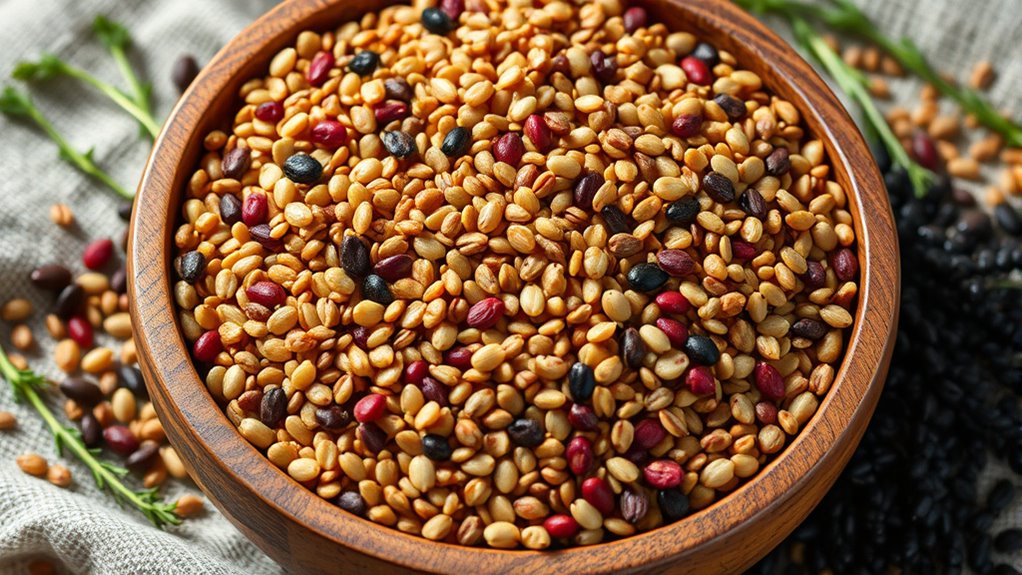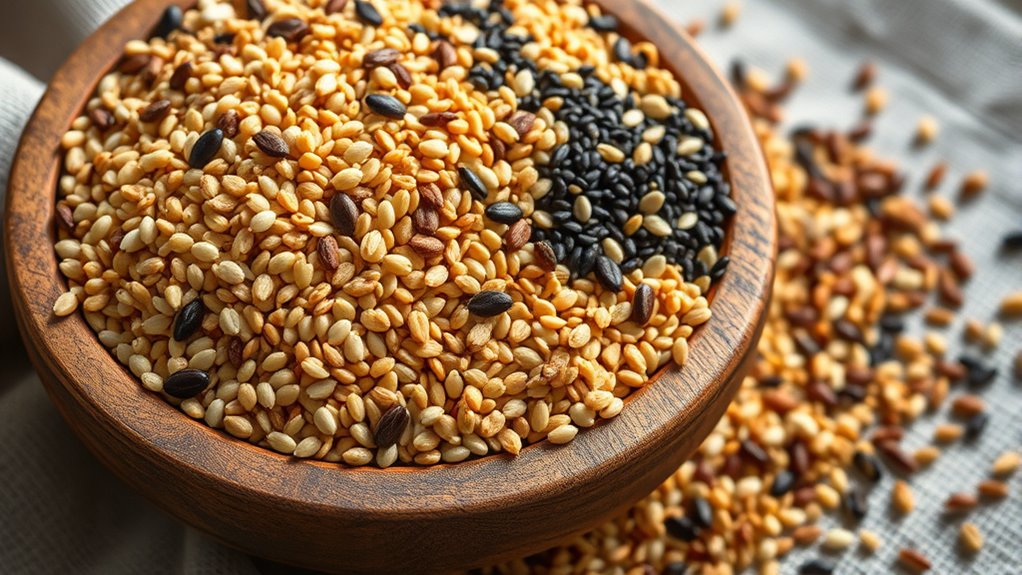Ancient grains are nutritional powerhouses that you can easily incorporate into your diet. Rich in fiber, vitamins, minerals, and antioxidants, they support your overall health, digestion, and energy levels. Many are naturally gluten-free or lower in gluten, ideal for sensitive diets. Not only do they offer hearty textures and bold flavors, but they also promote sustainable farming practices. Explore how these versatile grains can benefit you and discover simple tips to make them a regular part of your meals.
Key Takeaways
- Ancient grains are nutrient-dense, offering high levels of fiber, vitamins, minerals, and antioxidants that support overall health.
- They are versatile in cooking, suitable for salads, soups, porridge, and baking, enhancing flavor and texture.
- Rich in fiber and protein, they promote digestion, blood sugar regulation, and satiety, aiding weight management.
- Cultivating ancient grains is environmentally sustainable, requiring fewer resources and supporting eco-friendly farming practices.
- Incorporating these grains into daily diets helps preserve cultural heritage and maximizes health benefits.

Ancient grains are gaining popularity for their rich nutrients and unique flavors, offering a healthy alternative to modern staples. You might’ve heard of quinoa, farro, spelt, or amaranth, but these grains have been cultivated for thousands of years, long before modern wheat and rice became dominant. When you choose to incorporate ancient grains into your diet, you’re not just adding variety; you’re embracing foods packed with essential nutrients that support overall health.
These grains often contain higher levels of fiber, vitamins, minerals, and antioxidants than their more common counterparts, making them a smart choice for those looking to boost their nutritional intake. Their hearty textures and robust flavors also add depth to your meals, transforming simple dishes into satisfying, wholesome experiences.
You can easily swap out refined grains in your recipes with ancient grains, which are incredibly versatile. For example, cooking quinoa as a side dish or adding it to salads provides a protein-rich alternative to rice or pasta. Farro and spelt work well in soups, stews, and grain bowls, offering a chewy texture that satisfies the palate. Amaranth, with its slightly nutty flavor, can be used in porridge or baking. The key is to experiment and discover how these grains can enhance your favorite dishes.
Additionally, many ancient grains are naturally gluten-free or have lower gluten content, making them suitable options for people with gluten sensitivities or celiac disease.
Beyond their culinary appeal, ancient grains are often less processed than modern grains, which means they retain more of their natural nutrients. When you choose whole, minimally processed grains, you’re supporting better digestion and sustained energy release throughout the day.
Their high fiber content is particularly beneficial for maintaining healthy digestion, regulating blood sugar levels, and reducing cholesterol. Consuming these grains regularly can also contribute to better weight management by promoting satiety and reducing overeating.
Plus, they’re generally sustainable choices since many ancient grains require less water and fewer resources to cultivate, making them an environmentally friendly addition to your diet.
Incorporating ancient grains might seem intimidating at first, but once you get familiar with their cooking methods and flavor profiles, you’ll find them to be rewarding staples. Their rich history and powerful nutrient profile make them more than just trendy ingredients; they’re a way to reconnect with traditional, wholesome foods that support your health.
Frequently Asked Questions
How Do Ancient Grains Compare to Modern Grains Nutritionally?
You might wonder how ancient grains stack up against modern ones nutritionally. Generally, ancient grains like quinoa, farro, and millet offer more fiber, protein, and micronutrients than many modern grains such as refined wheat.
They often contain fewer additives and are less processed, making them a healthier choice. Incorporating these grains into your diet can boost your nutrient intake, improve digestion, and support overall well-being.
Are Ancient Grains Suitable for Gluten-Free Diets?
When it comes to gluten-free diets, you might think all grains are off-limits, but that’s not the case. Many ancient grains, like quinoa, millet, and buckwheat, are naturally gluten-free and packed with nutrients.
You can enjoy these grains without worry, broadening your options and adding variety to your meals. Think of ancient grains as hidden gems, offering tasty, wholesome alternatives that fit seamlessly into your gluten-free lifestyle.
What Are the Best Ways to Incorporate Ancient Grains Into Daily Meals?
You can incorporate ancient grains into your daily meals by swapping them for regular grains in your favorite recipes. Try adding cooked quinoa or farro to salads. Using millet or amaranth as a breakfast porridge is another great option. You can also replace rice with bulgur or freekeh in stir-fries.
Experiment with baking using spelt or einkorn flour. Snack on roasted chickpeas or popcorn made from ancient grains. These simple swaps boost nutrition and flavor.
Can Ancient Grains Help With Specific Health Conditions?
You might wonder if ancient grains can aid specific health conditions. They can, as many are rich in fiber, antioxidants, and nutrients that support heart health, improve digestion, and help regulate blood sugar.
For example, quinoa and amaranth may benefit diabetics, while oats can lower cholesterol. Incorporate these grains into your diet regularly, and you could see positive impacts on your overall well-being and management of certain health issues.
Are There Any Potential Allergens or Sensitivities Associated With Ancient Grains?
You might wonder if ancient grains cause allergies or sensitivities. While generally safe, some people react to grains like spelt or kamut, experiencing symptoms like bloating or digestive discomfort.
If you have gluten sensitivities or allergies, it’s wise to check labels and consult your healthcare provider.
Keep in mind that individual reactions vary, so start with small amounts to see how your body responds before incorporating them regularly into your diet.
Conclusion
As you explore ancient grains, you might wonder if they truly outperform modern staples. Evidence suggests these grains pack more nutrients and antioxidants, supporting overall health. While some argue their benefits are overstated, studies show they can diversify your diet and improve digestion. Embracing these time-tested foods isn’t just about nostalgia but about tapping into proven nutritional powerhouses. So, give ancient grains a chance—you could be rediscovering a lost secret to better wellness.









